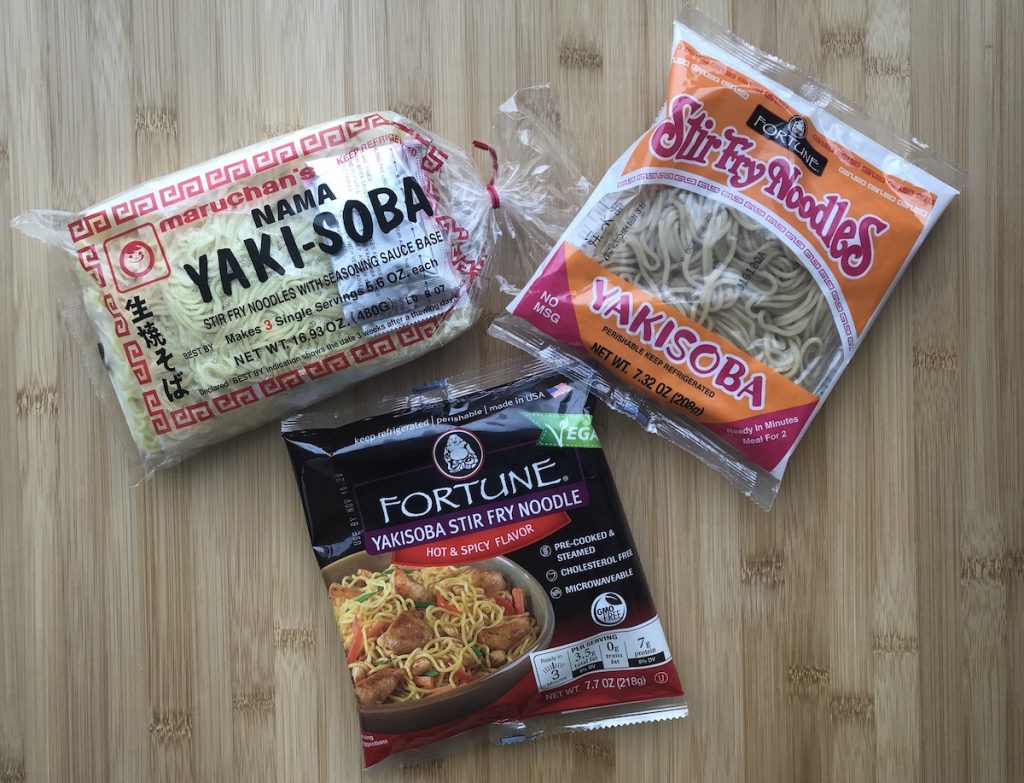Yakisoba is a savory, vegetable filled noodle dish that makes a great meal during the week. You can make it vegetarian, even vegan or add protein. Local grocery stores carry yakisoba kits with noodles and seasoning, or you can make it from scratch! It is really flexible and easy! (Just be sure to check ingredients as not all yakisoba seasoning is vegetarian or vegan.)
List of Ingredients for Yakisoba (1 serving)
- ¼ Head of cabbage — cleaned and thinly sliced
- ¼ Yellow onion (large) or ½ small — peeled and sliced
- 2 Green onion stems — cleaned and chopped into 1 inch pieces
- 1 Carrot — peeled and thinly sliced on the diagonal
(Can use other vegetables too!) - ~1/4 lbs chicken breast/thigh meat or preferred protein (optional) — thinly sliced
- Salt and pepper — lightly sprinkle salt and pepper while frying protein and while frying vegetables
- 1 Package of yakisoba noodles and seasoning (1 serving size)
- Oil for cooking meat and vegetables

List of Ingredients for Yakisoba Sauce (1 serving)

- ¼ C Ketchup
- 4 Tsp Worcestershire Sauce
- ½ Tsp Soy sauce or Tamari Sauce
- ½ Tsp Oyster Sauce (can omit)
Mix the above ingredients. This is very flexible and can be altered to your own tastes. This should be enough to make one serving (which is one single serving package of ramen or yakisoba noodles, plus vegetables).
List of Tools
- Large bowl or plate — to hold the sliced vegetables (additional plate if using protein)
- Vegetable peeler — if using carrots
- Cutting board and knife
- Small pot — to boil water to separate the noodles
- Colander — for draining the noodles
- Cooking chopsticks — to break apart noodles in water and to cook
- 2 Spatulas — I love my narrow and long spatulas from Ikea
- Wok like pot for cooking — medium size is sufficient
- Serving plate
Prepare the Chicken and Vegetables
Remove gristle or extra fat on chicken and slice thinly.
Thinly slice cabbage and yellow onion into strips and place in a bowl or on a plate. If using carrots, thinly slice on an angle and add to other ingredients. Cutting on an angle makes for pretty slices. Green onions should be cut into 1 inch lengths and set aside separately.
Prepare Noodles
Bring a medium pot of water to a boil. Add 1 package of noodles. Turn off the stove and let the noodles soften and separate. You can help separate the noodles with chopsticks but be patient, otherwise you will end up breaking the noodles into small pieces. Once the noodles separate nicely, drain in the colander and set aside.Cook the Protein
Heat the pot with 1 Tbs of oil on medium to medium high. Cook the chicken or preferred type of protein with some salt and pepper until thoroughly cooked. Set aside.
Cook the Vegetables
Add more oil if necessary and cook the crunchy vegetables (cabbage, yellow onion, carrots); just before those are fully cooked, add the green onions. Complete the frying until desired doneness. When using additional vegetables, always remember to cook the harder, crunchier vegetables first, then add other faster cooking vegetables towards the end.
Finish Cooking and Seasoning
Add the cooked chicken and the drained noodles into the pot with the vegetables. Toss to mix the ingredients a bit and then sprinkle in the seasoning packet. Toss again until thoroughly mixed, the dish is ready! Enjoy!
TIP: Too many veggies may weaken the flavor, which can be a problem if using packaged yakisoba. You can make a small amount of sauce, but many times just adding a bit of worcestershire sauce can help.
Also, don’t forget to submit a photo of your creations! You can upload your photos using my Contact form!

